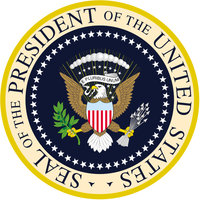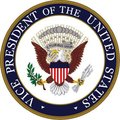James Madison
|
|
| ||
| Order: | 4th President | |
| Vice President: | George Clinton; Elbridge Gerry | |
| Term of office: | March 4, 1809 – March 4, 1817 | |
| Preceded by: | Thomas Jefferson | |
| Succeeded by: | James Monroe | |
| Date of birth: | March 16, 1751 | |
| Place of birth: | Port Conway, Virginia | |
| Date of death: | June 28, 1836 | |
| Place of death: | Montpelier, Virginia | |
| First Lady: | Dolley Madison | |
| Political party: | Democratic-Republican | |
James Madison (March 16, 1751 – June 28, 1836) was the fourth (1809–1817) President of the United States. He was co-author, with John Jay and Alexander Hamilton, of the Federalist Papers, and is traditionally regarded as the Father of the United States Constitution.
| Contents |
Biography
Madison was born in King George County, Virginia. His parents Colonel James Madison, Sr. (March 27, 1723 – February 27, 1801) and Eleanor Rose "Nellie" Conway (January 9, 1731 – February 11, 1829) were the prosperous owners of the tobacco plantation in Orange County, Virginia where Madison spent most of his childhood years. In 1769, he left the plantation to attend Princeton University (it was called the College of New Jersey at the time), finishing its four-year course in two years, but exhausting himself from overwork in the process. When he regained his health, he became a proteg頯f Thomas Jefferson. In this capacity he became a prominent figure in Virginia state politics, helping to draft their declaration of religious freedom and persuading Virginia to give their northwestern territories (consisting of most of modern-day Ohio, Kentucky and Tennessee) to the Continental Congress.
In the 1780s, Madison helped convince the political leaders of the time to call for a convention to replace the ineffective Articles of Confederation. Madison was the best prepared delegate at the Constitutional Convention, and his overall influence at Philadelphia in 1787 has led some historians to call him the "Father of the Constitution." Madison called for a strong central government with a bicameral legislature. When the issue arose of how states would be represented in the new Congress, Madison was one of the strongest advocates of state representation depending on population.
His notes from the Constitutional Convention are the best documentary evidence we have as to the thinking of what Thomas Jefferson (who was in France at the time) called an "assembly of demi-gods." To support Constitutional ratification in New York State, Madison put aside his doubts to work with Alexander Hamilton and John Jay to write the Federalist Papers, which are considered the definitive contemporary commentary on the Constitution of the U.S. Madison's arguments were powerfully influenced by the political thought of Charles de Secondat, Baron de Montesquieu.
Madison wrote thirty of the eighty-five essays that comprise the Federalist Papers. His most famous passage comes in Federalist No. 51:
- "If men were angels, no government would be necessary. If angels were to govern men, neither external nor internal controls on government would be necessary. In forming a government which is to be administered by men over men, the great difficulty lies in this: you must first enable government to control the governed; and in the next place oblige it to control itself."
When the Constitution was ratified, Madison became a U.S. Representative from his home state of Virginia. He successfully proposed the first ten amendments to the Constitution, known collectively as the Bill of Rights, based on earlier work by George Mason. The chief characteristic of Madison's time in Congress was his desire to limit the power of the federal government. When he and the other followers of Thomas Jefferson denied the power of the federal government to form its own bank that the first political parties in the United States were formed: the Federalists, who followed Hamilton and believed in a strong central government, and the Democratic-Republicans, who followed Jefferson and believed strongly in limiting centralized power.
At 5 ft 4 in (163 cm) and 100 pounds (45 kg), Madison was the nation's shortest president and frequently ill. In 1794 Madison married Dolley Payne Todd, who cut as attractive and vivacious a figure as he did a sickly and antisocial one. It was Dolley who is largely credited with inventing the role of "First Lady" as political ally to the president.
In 1797 Madison left Congress; in 1801 he became Jefferson's Secretary of State.
Presidency
In the election of 1808, Madison ran for president in his own right, and won, largely on the strength of his abilities in foreign affairs at a time when United Kingdom (Britain) and France were both on the edge of war with the United States. Both countries blockaded the ports of the other, preventing commerce with either. In 1810, a bill was passed that would break off relations with any nation that would not remove the blockade: France did, and Britain did not.
In the ensuing War of 1812, the British won numerous victories, including a temporary occupation of Washington, D.C., forcing Madison to flee the city. The British also armed American Indians in the West, most notably followers of Tecumseh. Neither side was terribly enthusiastic about the war, however: the British had little to gain, and in the United States, New England Federalists threatened secession if the war was not ended. In 1814, the Treaty of Ghent ended the war. The Battle of New Orleans (1815), in which Andrew Jackson distinguished himself, was fought 15 days after the treaty was signed — the news not reaching Louisiana in time from Belgium. The major lasting effect for the political face of the country was the end of the Federalist party, who were considered traitors when they opposed the war.
Cabinet
| OFFICE | NAME | TERM |
| President | James Madison | 1809–1817 |
| Vice President | George Clinton | 1809–1812 |
| Elbridge Gerry | 1813–1814 | |
| Secretary of State | Robert Smith | 1809–1811 |
| James Monroe | 1811–1814 | |
| James Monroe | 1815–1817 | |
| Secretary of the Treasury | Albert Gallatin | 1809–1814 |
| George Campbell | 1814 | |
| Alexander J. Dallas | 1814–1816 | |
| William Crawford | 1816–1817 | |
| Secretary of War | William Eustis | 1809–1812 |
| John Armstrong, Jr. | 1813 | |
| James Monroe | 1814–1815 | |
| William Crawford | 1815–1816 | |
| George Graham (ad interim) | 1816–1817 | |
| Attorney General | Caesar A. Rodney | 1809–1811 |
| William Pinkney | 1811–1814 | |
| Richard Rush | 1814–1817 | |
| Postmaster General | Gideon Granger | 1809–1814 |
| Return Meigs | 1814–1817 | |
| Secretary of the Navy | Paul Hamilton | 1809–1813 |
| William Jones | 1813–1814 | |
| Benjamin Crowninshield | 1815–1817 | |
Supreme Court Appointments
Madison appointed the following Justices to the Supreme Court of the United States:
States Admitted to the Union
Later Life
After leaving office, Madison retired to Montpelier, his farm in Virginia. He was briefly the rector of Jefferson's University of Virginia, but spent most of his days farming. Madison was the first president of the American Colonization Society, which bought passage for free black Americans to the Society's colony in west Africa, Liberia. When he died on June 28, 1836, by the terms of his will, $2000 was bequeathed to the ACS through its tireless agent Rev. Dr. Ralph Randolph Gurley but his "ownership in the negroes and people of color" he bequeathed to his wife.[1] (http://www.jamesmadisonmus.org/resources/will.htm) Madison was a slaveholder throughout his entire life.
Madison's portrait was on the U.S. $5000 bill. There were about twenty different varieties of $5000 bills issued between 1861 and 1946, and all but three had James Madison. Madison also appears on the $200 Series EE Savings Bond.
Quotes
"Resolved, That the General Assembly of Virginia, doth unequivocally express a firm resolution to maintain and defend the Constitution of the United States, and the Constitution of this State, against every aggression either foreign or domestic ... That this Assembly doth explicitly and peremptorily declare, that it views the powers of the federal government, as resulting from the compact, to which the states are parties; as limited by the plain sense and intention of the instrument constituting the compact; as no further valid than they are authorized by the grants enumerated in that compact; and that in case of deliberate, palpable, and dangerous exercise of other powers, not granted by the said compact, the states who are parties thereto, have the right, and are in duty bound, to interpose for arresting the progress of the evil, and for maintaining within their respective limits, the authorities, rights and liberties appertaining to them."
"...[T]he government of the United States is a definite government, confined to specified objects. It is not like the state governments, whose powers are more general. Charity is no part of the legislative duty of the government."
"I cannot undertake to lay my finger on that article of the Constitution which granted a right to Congress of expending, on objects of benevolence, the money of their constituents." 1794 (Pertaining to Congress' appropriation $15,000 for relief of French refugees)
"A standing military force, with an overgrown Executive will not long be safe companions to liberty. The means of defence agst. foreign danger, have been always the instruments of tyranny at home. Among the Romans it was a standing maxim to excite a war, whenever a revolt was apprehended. Throughout all Europe, the armies kept up under the pretext of defending, have enslaved the people." -- Constitutional Convention June 29, 1787
Related articles
- U.S. presidential election, 1808
- U.S. presidential election, 1812
- List of places named for James Madison
- List of U.S. Presidential religious affiliations
Writings
- James Madison: Writings by James Madison (1999, ISBN 1883011663)
History Clipart and Pictures
- Pictures of the US Presidents (http://classroomclipart.com/cgi-bin/kids/imageFolio.cgi?direct=History/United_States/Presidents)
- Clipart of American Presidents (http://classroomclipart.com/cgi-bin/kids/imageFolio.cgi?direct=Clipart/American_Presidents)
- Historical Pictures of the United States (http://classroomclipart.com/cgi-bin/kids/imageFolio.cgi?direct=History/United_States)
- Pictures of the American Revolution (http://classroomclipart.com/cgi-bin/kids/imageFolio.cgi?direct=History/United_States/American_Revolution)
- Civil Rights Pictures (http://classroomclipart.com/cgi-bin/kids/imageFolio.cgi?direct=History/United_States/Civil_Rights)
- Civil War Images (http://classroomclipart.com/cgi-bin/kids/imageFolio.cgi?direct=History/United_States/Civil_War)
- Pictures of Colonial America (http://classroomclipart.com/cgi-bin/kids/imageFolio.cgi?direct=History/United_States/Colonial_America)
- Historical US Illustrations (http://classroomclipart.com/cgi-bin/kids/imageFolio.cgi?direct=History/United_States/Illustrations)
- World War II Pictures (http://classroomclipart.com/cgi-bin/kids/imageFolio.cgi?direct=History/United_States/World_War_II)
- Pictures of Historical People (http://classroomclipart.com/cgi-bin/kids/imageFolio.cgi?direct=History/United_States/People)
External links
- The James Madison Papers, 1723-1836 (http://lcweb2.loc.gov/ammem/collections/madison_papers/) from the Manuscript Division at the Library of Congress, approximately 12,000 items captured in some 72,000 digital images.
- The Papers of James Madison (http://www.yale.edu/lawweb/avalon/presiden/madispap.htm) from the Avalon Project
- James Madison's brief biography (http://Madison.thefreelibrary.com/)
- Madison's last will and testament, 1835 (http://www.jamesmadisonmus.org/resources/will.htm)
- A history of the Madison family since the 17th century (http://www.jmu.edu/madison/family/)
- Official White House page for James Madison (http://www.whitehouse.gov/history/presidents/jm4.html)



